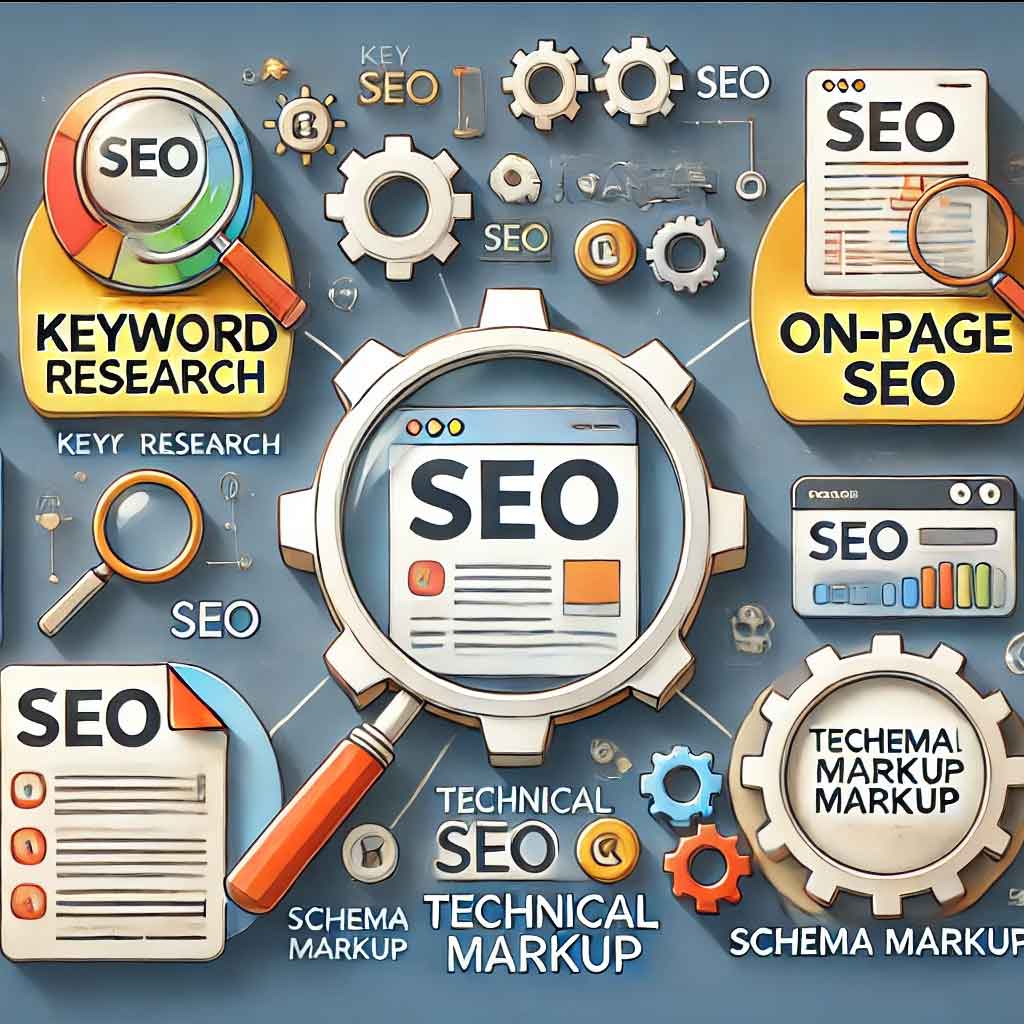SEO & E Commerce
Understanding SEO & Conversion Optimization

Introduction to SEO and Conversion Optimization
Whether you have an online store, a professional website, or a personal blog, Search Engine Optimization (SEO) and conversion optimization are critical for your success. This section will break down these concepts in simple terms and explain how they work together to help your site attract, engage, and convert visitors into loyal followers or clients.
Attracting Visitors with SEO
What is SEO?
SEO stands for Search Engine Optimization. It’s all about making your website more visible on search engines like Google. When someone searches for the services, products, or content you offer, good SEO practices can help your site show up higher in the search results, bringing more visitors to your site.
1. Keyword Research:
- Keywords are the words and phrases people type into search engines.
- By identifying popular keywords related to your offerings, you can include them in your website content to attract more visitors.
2. On-Page SEO:
- This involves optimizing the content on your website, including page titles, meta descriptions (the short summaries that appear under your page title in search results), headers, and the content itself.
- Using relevant keywords naturally in your content makes it easier for search engines to understand what your page is about.
3. Technical SEO:
- This focuses on the backend of your website.
- Improving site speed, ensuring your site works well on mobile devices, and having a clear structure are all part of technical SEO.
- Using SSL certificates (the “https” in your URL) secures your site and also helps with SEO.
4. Schema Markup:
- Schema markup is a type of code you can add to your website to help search engines understand your content better.
- It can display additional information like product prices, availability, and reviews directly in search results, making your listing more appealing.


Engaging Visitors with User Experience (UX) Enhancements
Enhancing User Experience:
Once visitors land on your site, the goal is to keep them engaged and encourage them to explore further. This is where a good user experience (UX) comes in. UX is crucial because it represents your brand. A positive experience can make visitors appreciate your brand and value proposition more.
1. Clear Navigation:
- Ensure that your site’s navigation is intuitive and easy to use.
- A well-organized menu and clear call-to-actions (CTAs) help visitors find what they are looking for quickly.
2. Compelling Content:
- High-quality images, videos, and detailed descriptions can help showcase your services or products effectively.
- Engaging blog posts, case studies, and portfolio items can keep visitors interested.
3. Mobile-Friendly Design:
- Make sure your website is optimized for mobile devices. A significant portion of web traffic comes from mobile users, and a responsive design ensures a good experience for them.
4. Customer Reviews and Testimonials:
- Enabling customer reviews and highlighting testimonials can build trust and provide social proof, which is crucial for both e-commerce and professional sites.
Building a Strong Brand with Compelling Narratives
Storytelling:
Using storytelling to create an emotional connection with your audience enhances your brand’s appeal:
1. Brand Mission and Values:
- Clearly communicating what your brand stands for and what you aim to achieve.
2. Customer Stories:
- Sharing testimonials and success stories from happy customers or clients shows the real-world benefits of your offerings.
3. Behind-the-Scenes:
- Giving a peek into your process or the team behind your brand can make your business feel more personal and trustworthy.
Converting Visitors into Clients or Followers
Conversion Rate Optimization (CRO):
Conversion optimization is about turning visitors into customers, clients, or followers. Here’s how you can do it:
1. Clear Call-to-Actions (CTAs):
- CTAs are the buttons or links that tell visitors what to do next, like “Contact Us,” “Subscribe,” or “Buy Now.”
- Make sure they are easy to see and understand.
2. Trust Signals:
- Displaying security badges, return policies, and customer testimonials prominently to build trust.
3. A/B Testing:
- This involves testing different versions of your website to see which one performs better.
- You can test different headlines, button colors, layouts, etc., to find the most effective combination.
Retargeting:
Sometimes, visitors leave your site without taking any action. Retargeting helps bring them back:
1. Email Retargeting:
- Sending emails to remind visitors about items left in their cart or encouraging them to subscribe to your newsletter can be effective.
2. Ad Retargeting:
- Showing ads to previous visitors as they browse other websites or social media can remind them of your services or products and entice them to return.


Consistent Branding:
Maintaining a consistent look and feel across all your marketing materials builds a strong brand identity:
1. Visual Identity:
- Use the same colors, fonts, and logos on your website, social media, and other marketing materials.
2. Brand Voice:
- Develop a unique voice that reflects your brand’s personality and use it consistently in all your communications.
The Importance of UX in Branding
User Experience (UX) as Brand Representation:
Your website’s UX is a direct representation of your brand. A positive UX helps in getting the right people to appreciate your brand and value proposition. Here’s why it’s important:
1. First Impressions:
- Your website is often the first point of contact with potential customers or clients. A well-designed, user-friendly site makes a strong first impression.
2. Building Trust:
- A seamless and intuitive experience builds trust with visitors. If they find your site easy to navigate and informative, they are more likely to trust your brand.
3. Customer Retention:
- A positive experience keeps visitors coming back. Happy customers or clients are more likely to become repeat buyers or long-term clients and recommend your brand to others.
4. Differentiation:
- A unique and enjoyable UX sets your brand apart from competitors. It can be a key differentiator in a crowded market.
Conclusion
By understanding and implementing SEO and conversion optimization, along with a strong focus on user experience and branding, you can create a powerful online presence. This holistic approach not only attracts, engages, and converts a broader audience but also builds a loyal customer or client base. Whether you run an online store, a professional website, or a personal blog, these strategies ensure long-term success and growth for your online presence.

